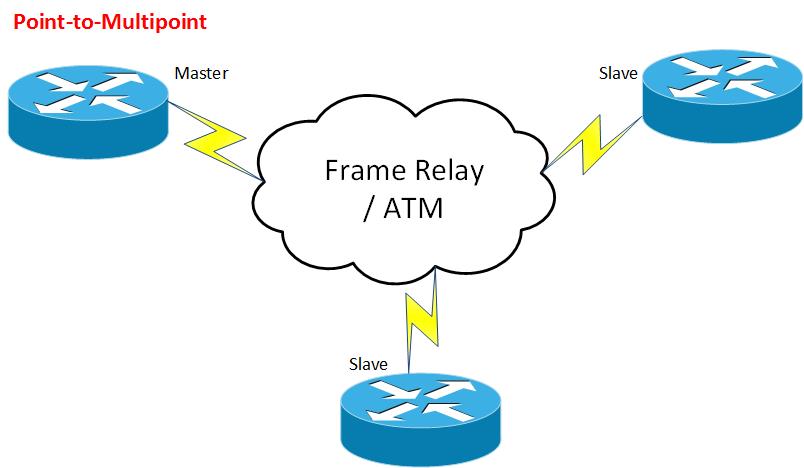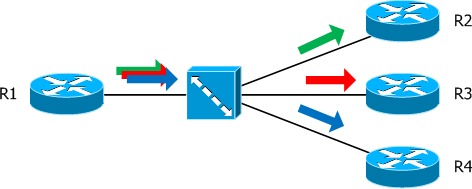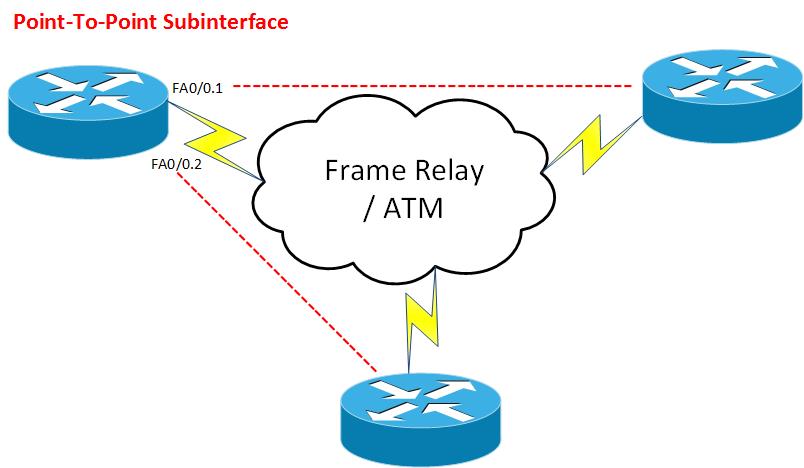OSPF Network Types:
[boxads] There are several kind of OSPF Network Types are use in service provider environment. OSPF message addresses are determined by the type of network to which the OSPF interface is connected. One of the following OSPF network types must be selected when configuring an interface on an OSPF router.
Point-to-Point: A network that can connect only two routers. Leased-line WAN links such as Dataphone Digital Service (DDS) and T-Carrier are point-to-point networks. OSPF messages sent on point-to-point networks use IP multicast addresses.
- No DR/BDR concept.
- Has a Master and Slave concept instead, with highest interface chosing the Master, but can be manually set.
- Default Priority = 0
- Multicast = 224.0.0.5
- Hello Timer = 10
- Hello Dead Timer = 40
- 1 Common Subnet

Point-to-Multipoint: A point-to-multipoint configuration approaches the non-broadcast limitation in a different manner. Rather than trying to emulate broadcast capability, it seeks to organize the PVCs into a collection of point-to-point networks. Hello packets must still be replicated and transmitted individually to each neighbor, but the multipoint approach offers two distinct advantages: no DR/BDR is needed, and the emulated point-to-point links can occupy a common subnet.All routers attached to a non-broadcast network must be manually configured to recognize it as a point-to-multipoint segment:
Router(config-if)# ip ospf network point-to-multipoint [non-broadcast]
The non-broadcast parameter can be appended to the OSPF network type to force unicasting of packets rather than relying on multicast. This might be necessary when dynamic circuits are in use.
[adsense]
- Master/Slave concept is used (not DR/BDR)
- Hellos are sent on 224.0.0.5
- Hello Timer = 30 Seconds
- Hello Dead Timer = 120 Seconds
- 1 Common Subnet
- There are known issues with split horizon (the use of same/similar subnets at two different “sites”)

Broadcast: A network that can connect more than two routers with a hardware broadcast facility where a single packet sent by a router is received by all routers attached to that network. Ethernet, Token Ring, and FDDI are broadcast networks. OSPF messages sent on broadcast networks use IP multicast addresses.
- Hellos sent on 224.0.0.5
- Priority = 1
- Hello Timer = 10
- Hello Dead Timer = 40
- 1 Common Subnet

Non-Broadcast Multiple Access: A network that can connect more than two routers but has no hardware broadcast facility. X.25, Frame Relay, and ATM are Non-Broadcast Multiple Access (NBMA) networks. Because multicasted OSPF messages do not reach all the OSPF routers on the network, OSPF must be configured to unicast to the IP addresses of the routers on the NBMA network.
- No Mutlicast of Hello Packets
- No auto-discovery of nieghbors (Relies on manual neighbor setup)
- Uses DR/BDR concept
- Hello Timer = 30 Seconds
- Hello Dead Timer = 120 Seconds
- 1 Common Subnet

Point-to-Point Subinterface:
- Hellos are mutlicast
- Master/Slave Concept (Not DR/BDR concept)
- 1 virtual-circuit per subnet
- No split horizon issues (oppose to Point-to-Multipoint)
- Hello Timer = 10 Seconds
- Hello Dead Timer = 40 Seconds

Note: The use of OSPF over non permanent, non-persistent, dial-up WAN links such as analog phone lines or ISDN is not recommended.

